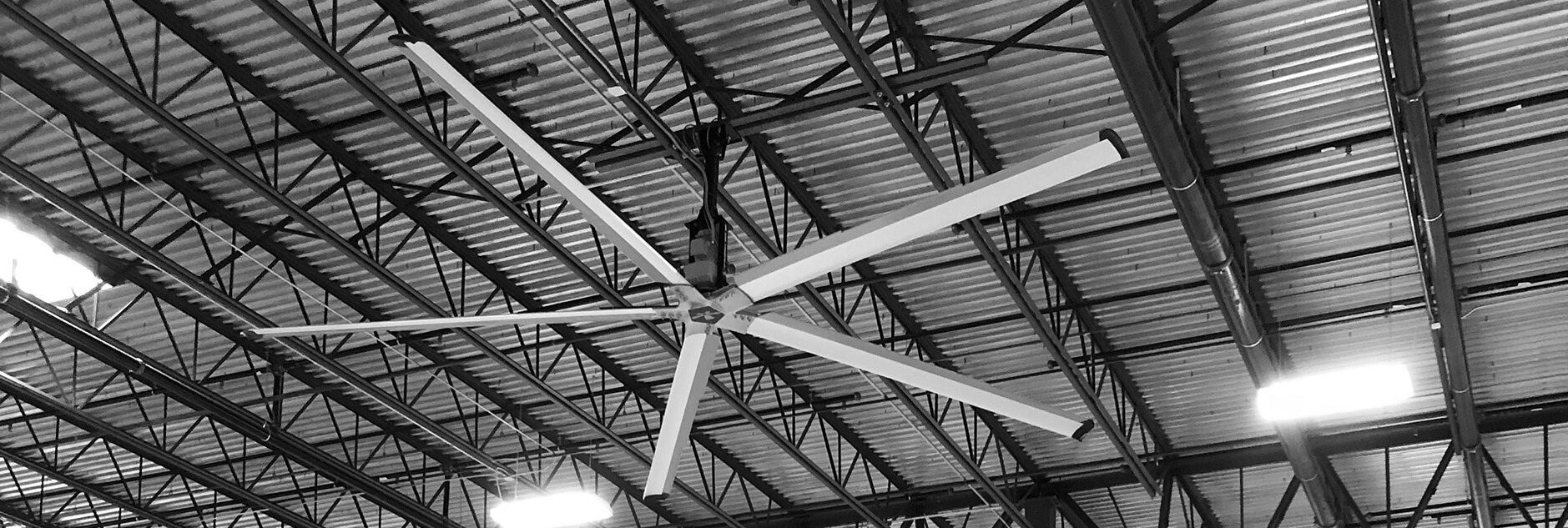Environmental Benefits Of HVLS Fans


High-volume, low-speed (HVLS) fans are causing a revolution in the way large, open-space, industrial and commercial facilities handle the challenges of air quality control. It’s no wonder, considering the benefits these energy-efficient fans provide. Areas of major concern for managers of large facilities have pushed the use of HVLS fans to the forefront of air quality control.
Managers need to control costs and protect their facilities and employees from damage, illness and injury — as well as do the right thing to protect the environment. Much of that protection depends on a facility’s air quality control systems. HVLS energy-efficient ceiling fans offer year-round quality air control — which cuts expenses, reduces the carbon footprint and keeps their facility running efficiently.
HVLS fans work alone or in conjunction with heating, ventilation and air-conditioning units (HVAC) to create better workspace environments. One 7-foot diameter HVLS fan can cool 5,000 square feet, moving 80,000 cubic feet per minute for a fraction of the cost of conventional fans. Massive air movement creates a perceived temperature drop of 7-10 degrees Fahrenheit — making employees feel much cooler even though the actual air temperature has not been significantly reduced. This can save considerable energy over the course of the cooling season.
Cold buildings can cause problems, too. When your facility is equipped with HVLS fans, you can reclaim the warm air that floats up to the rafters. In a process known as destratification, your HVLS energy-saving fan will draw heated air down and mix it with cooler air that settles near the floor. When your HVLS fan is operating, you can turn your thermostat down and maintain warm temperatures while reducing energy consumption and saving money.
Sick Building Syndrome (SBS) can be traced to faulty, dirty and dysfunctional HVAC units. HVLS fans help to clear fumes, dust and more from the air, keeping your interior air clean and reducing the onset of SBS.
Sweating Slab Syndrome (SSS) is another hazard of buildings with poor air quality. When a building’s environment is plagued with high humidity, danger lurks on any cool surface. As typical industrial ceiling fans push warm air down, the moisture in the air condenses and pools on the cool floor, causing SSS. With HVLS fans, the warm air moves more slowly, giving moisture time to evaporate before it reaches the floor. Dry floors mean fewer slipping and falling accidents.
Wet floors are not the only issue caused by condensation. Without HVLS fans in your facility, heavy equipment can develop corrosion and rust, causing expensive damage. Wooden and paper packaging can also become damp, inviting mold and mildew to wreak havoc on supplies stored in your warehouse as well as putting your employees’ health at risk.
HVAC ductwork hinders the efficiency of air quality systems. If a facility is designed with an HVLS fan system, some (or all) of the HVAC equipment and ductwork can be eliminated — thereby decreasing labor and material costs, and reducing the amount of space allocated for the system. Because HVLS fans are reversible, they function efficiently year-round — with or without an HVAC system — further reducing a facility’s carbon footprint.
For the price of HVAC ductwork, you could install an HVLS fan. Considering the cost- and energy-saving benefits of HVLS, wouldn’t you rather have a sleek, energy-saving fan hanging from your ceiling instead of clunky, energy-robbing ductwork? Go Fan Yourself offers a variety of HVLS fans that can fix any air quality problems your building faces. Check out all of our energy-efficient ceiling fans here or call 844-GO-FAN-ME for more information.
